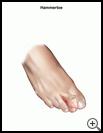
Hammertoe
________________________________________________________________________
KEY POINTS
- A hammertoe is when the middle joint of one of your toes raises up so that the toe bends in a shape like a hammer. The bent joint may rub the top of your shoe and cause a callus.
- Your healthcare provider may treat your hammertoe with taping, exercises, or surgery. Try to find shoes that are soft, roomy, and comfortable.
- See your healthcare provider if you have foot pain that does not go away quickly or is more than mild pain.
________________________________________________________________________
What is a hammertoe?
A hammertoe is when the middle joint of one of your toes raises up so that the toe bends in a shape like a hammer. The bent joint may rub the top of your shoe and cause a callus. Hammertoes are most common in the second toe.
What is the cause?
Some causes of hammertoe are:
- Shoes that are too tight, too short, or have high heels. When shoes do not fit well, the pressure of the shoes pushes your toes into a bent position over time. After a while, your muscles can’t straighten the toe, even when you are not wearing shoes.
- Injury or a disease such as arthritis or diabetes that affects the nerves and muscles. If you have an injury or disease that damages the nerves or muscles in your toes, the toe may stay in the bent position until the tendons become permanently shortened. Tendons are strong bands of tissue that attach muscle to bone.
- A bunion, which is a bump at the base of the great toe, may cause a hammer toe as the bunion gets bigger.
The risk of developing a hammertoe increases with age. Women are more likely to develop a hammertoe than men.
What are the symptoms?
Symptoms may include:
- Pain in the bent toe or toes when you wear shoes, making it hard or painful to walk
- A corn or callus on the top of the joint caused by rubbing against the shoe
- Swelling and redness of the skin over the joint
A hammertoe may not be painful at first, and can be pushed down to the correct position. This is called a flexible hammertoe. After a while, it will not go back to a normal position, even if pushed with manually or with a brace. This is called a rigid hammertoe.
How is it diagnosed?
Your healthcare provider will ask about your medical history and symptoms and examine you. Your provider will also check the flexibility of your toes and test how much feeling you have in your toes.
You may have blood tests to check for diseases that may cause foot problems, such as diabetes or arthritis.
X-rays: Pictures of your foot to check for arthritis.
How is it treated?
If you have a flexible hammertoe, your healthcare provider may:
- Splint or tape the toe into the correct position
- Show you how to use your fingers to stretch your toes and toe joints toward a more normal position
- Suggest that you exercise your toes by trying to pick up marbles with them or by wadding up a towel on the floor with your toes
- Use padding to change where your weight falls when you walk on the foot.
- Suggest you wear shoes that have a larger toe box.
If you have a rigid hammertoe, you will need surgery to return your toe to a better position.
How can I take care of myself?
- Try to find shoes that are soft, roomy, and comfortable. Avoid tight shoes or shoes with high heels. A shoe repair shop may be able to stretch your shoes to make room for your hammertoe.
- Try a pumice stone, foot file or foot soak designed to gently remove calluses. If you have a corn or a callus that is causing pain or preventing you from walking, a podiatrist (foot specialist) can shave down the corn or callus. Never use a razor or scissors to shave a corn or callus at home or at a nail salon.
- Follow your healthcare provider's instructions. Ask your provider:
- If there are activities you should avoid and when you can return to your normal activities
- How to take care of yourself at home
- What symptoms or problems you should watch for and what to do if you have them
- Make sure you know when you should come back for a checkup. Keep all appointments for provider visits or tests.
How can I help prevent a hammertoe?
The best ways to prevent a hammertoe are:
- Wear shoes that fit well. Shoes should be one-half inch longer than your longest toe. Shoes should be wide enough and the toe box should be high enough to give your foot room to move.
- Don’t wear shoes with heels over 2 inches high.
- If a toe starts to look like a hammertoe, buy shoes that have an extra high toe box. Wear corn pad removers or cushion pads on top of that toe.
- See your healthcare provider if you have foot pain that does not go away quickly or is more than mild pain. Foot pain is not normal.

